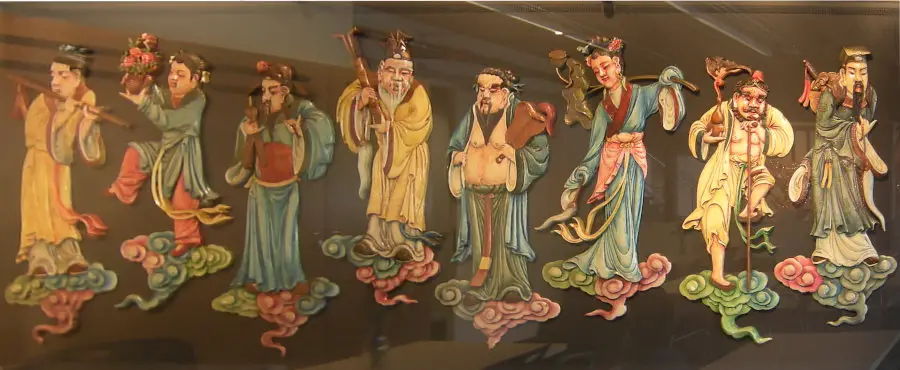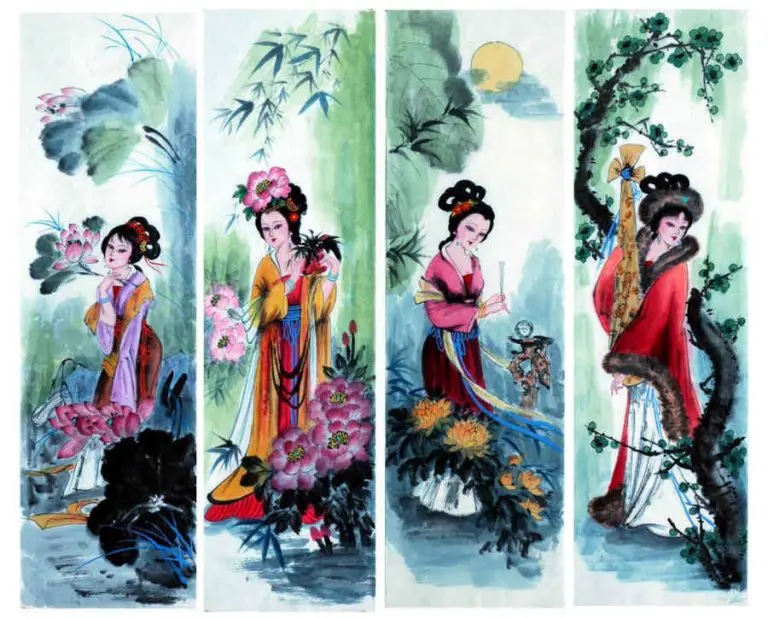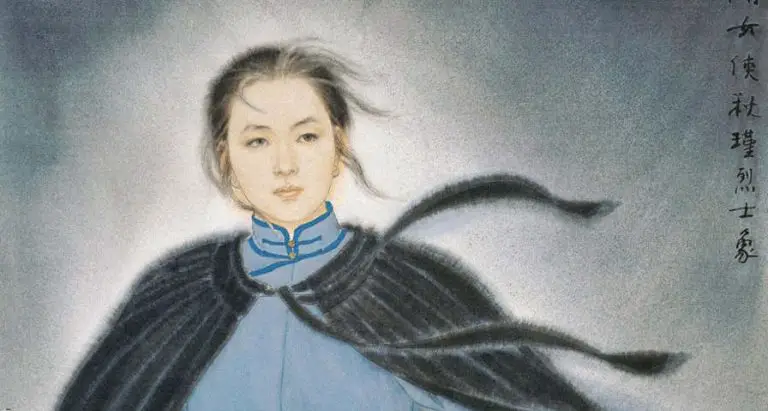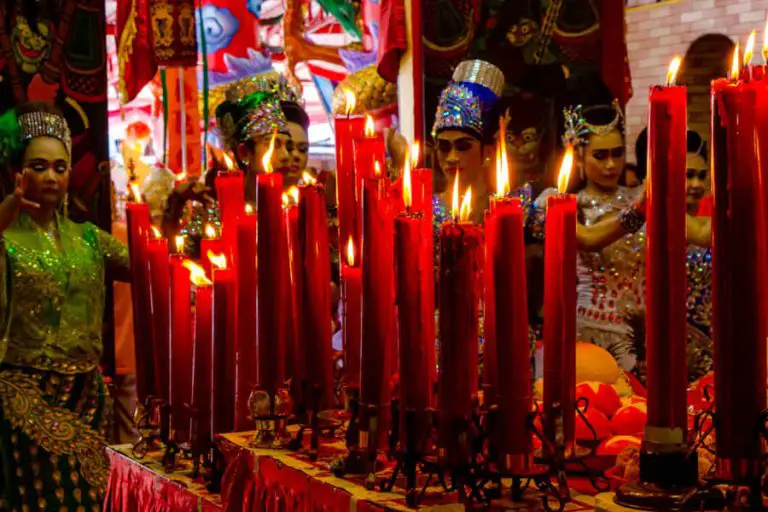This is the second article on eight immortals. In the previous article, we talked about who the eight immortals are, their origin, and their powers. It would be helpful to read it before this article to get a much better idea of the subject. (Click here: The Eight Immortals in Chinese Mythology)
Here we will discuss the role of eight immortals in modern Chinese culture and their use as Feng shui symbols.
The Eight Immortals are one of the most well-known figures in Chinese popular culture. They are said to bring happiness and wealth; hence, their representations are prevalent during many important events (such as marriages, childbirth, and New Year’s celebrations). Their depictions (or symbols) appear on banners, infant bonnets, temple roofs, greeting cards, and even women’s clothes.
Traditional theater and opera performances start with a “short but obligatory ritual playlet” that shows immortals dancing, drinking, laughing, and doing kung-fu.
They are also employed in Chinese geomancy (feng shui) since each immortal has come to be associated with a certain hexagram of the Yi Jing (I Ching) and consequently can be used to counteract the influence of any potentially harmful energies from that direction.
But most people know about the Eight Immortals from folk tales told by grandparents and professional storytellers.
Many books and anthologies have been written about their adventures. Some examples are:
- “The Emergence of the Eight Immortals and their Travels to the East” by Wu Yuantai (吳元泰), is arguably the most significant of these writings.
- “The Eight Immortals Cross the Sea”, a work from the Ming Dynasty that has not been attributed
- “The Yueyang Mansion” by Ma Zhiyuan (馬致遠)
- “The Bamboo-leaved Boat” by Fan Zi’an (范子安)
- “The Willow in the South of the City” by Gu Zijing (谷子敬)
Even now, the Ba Xian remains a popular topic in art, literature, television, and cinema. Some examples are:
- Jackie Chan’s movie Drunken Master is based on the story of the Ba Xian. The Ba Xian also appear in the animated show Jackie Chan Adventures.
- The Eight Immortals are an important part of the story in the video game Fear Effect 2.
- In the X-Men universe, the Eight Immortals emerge to safeguard China from the demonic mutant Xorn.
- The Immortal Iron Fist comic book series features eight extra-dimensional kung-fu warriors known as the “Eight Immortal Weapons” (based on the Ba Xian) who arrive to protect the Earth in times of need.
- The Eight Immortals return in Andy Seto’s graphic novel series Saint Legend to guard the Buddhist faith from demonic spirits that aim to destroy it.
- The second album by Asian-American death metal band Ripped to Shreds, 亂 (Luan) (2020), has a song about the Eight Immortals called “Eight Immortals Feast”
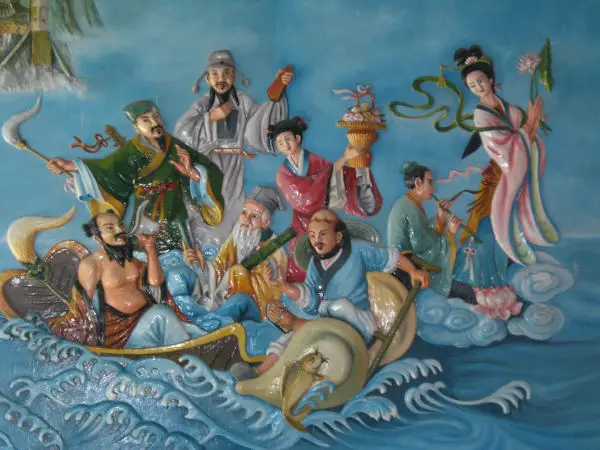
The 8 Immortals in Martial Arts and Qigong
They have also been linked to the early development of qigong activities like the Eight-Piece Brocade. Some Chinese martial arts systems are named after them, and they employ combat tactics based on the qualities of each immortal. Some drunken boxing styles make considerable use of the Eight Immortals archetypes for conditioning, qigong/meditation, and fighting training. There are methods for each of the eight immortals in one section of the drunken fist training for BaYingQuan.
The 8 Immortals in Feng shui
Now that we know what the eight immortals symbolize, the next issue is how to apply these powerful symbols in feng shui.
Because each of the Eight Immortals guards one of the eight directions, their presence in the home assures overall good feng shui. There is nothing to be afraid of while they are around. They provide longevity, fortune, good descendants, money, a good name, and recognition. They also promote compassion and spiritual generosity. Because they are saints, they represent everything positive, pure, and energizing.
Most people believe that putting a painting or sculpture of the 8 immortals together in the house will bring good luck everywhere except the bathroom, bedroom, kitchen, and garage.
They make fantastic artwork for living spaces, representing having them as visitors who bring good luck and health blessings. However, avoid configuring a placement in which they face you.
For example, if you’re hanging it as a framed painting in the living room, don’t position it so that it faces the sofa. This would be an open confrontation with the family on the sofa.
It is never a good idea in feng shui to face heavenly entities and symbolic beings directly.
If it must be in the living room, a decent location would be alongside and behind the sofa. This would imply that the people on the sofa are facing the same way as the image. This represents the support of the eight immortals.
Want to learn more about Feng Shui? Take a look at these Courses and Books – Aff.link
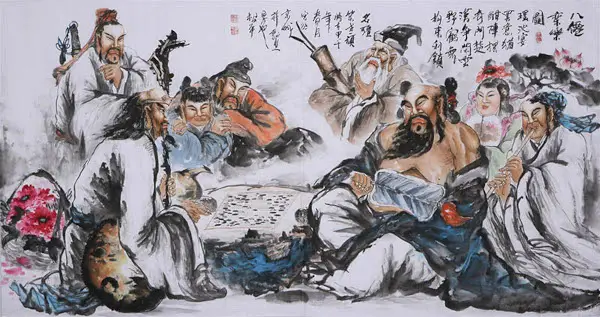
Paintings sometimes represent the eight immortals relaxing under a tree, where they typically unite as friends by simply hanging out. Playing chess on occasion. This has them in a calm and peaceful state. Making it beneficial to family peace
They are also shown in a dragon boat, presumably on their path to heaven. This represents the expectation of favorable circumstances and good fortune.
Overall, the positive meanings associated with the 8 immortals make them excellent feng shui décor pieces that may enhance positive energy and disperse bad energy surrounding the location in which they are placed.
In feng shui, it is also widely known and used that putting a picture of all eight immortals in certain parts of the house makes the qualities of the immortal represented by that part of the house stronger.
For example, if the artwork is put in the northeast portion of the home, it is Cao Guojiu’s domain. As a result, the members of the household would benefit from increased positive energy focused on status, power, and recognition.
Use the following chart as a guideline for displaying the immortals separately, and put the individual artwork of specific characters in the right positions to harness the energy they symbolize.
| Immortal | Direction | Element | Trigram |
|---|---|---|---|
| He Xian Gu | Southwest | Earth | Kun |
| Cao Guo Jiu | Earth | Northeast | Ken |
| Li Tie Guai | Fire | South | Li |
| Lan Caihe | Metal | Northwest | Chien |
| Lü Dongbin | Metal | West | Tui |
| Han Xiang Zi | Wood | Southeast | Sun |
| Zhang Guo Lao | Water | North | Kan |
| Zhongli Quan | Wood | East | Chen |
To elaborate, each of the 8 immortals can help you achieve your feng shui goals, as described below.
He Xian Gu (何仙姑)
Her element is earth, and her direction is southwest. Taoists think she is still alive, but she is almost 1,400 years old. When she was 14, she was given the priceless Peach of Immortality, and she became immortal.
She is seen carrying a magical lotus blossom, the flower of celestial brilliance that represents her strength and purity. She is sitting on a deer, which is a sign of vitality and long life. She helps people who are in desperate situations and need divine help. She brings good fortune to marriages and families.
Cao Guo Jiu (曹國舅)
His element is earth, and his direction is northeast. His sister was a Sung Empress, and he is one of two royal brothers. His emblem is the castanets, which he plays in a calm and relaxing pattern to help him meditate and go across the universe.
He rides a Pi Yao, whose spirit aids him in uncovering the truths of the Tao and immorality. He is reported to still be alive on Earth. It is stated that having him in the house invokes his protective presence. He is like a great defender who protects you without your knowledge. He is a fantastic companion for students who desire to succeed in their academics.
Li Tie Guai (李鐵拐)
His element is fire, and his direction is south. He is shown as a beggar with an iron crutch and a magical staff. His symbols are the staff and the gourd (a universal medicine symbol). He can transform things and create medicines and potions from his gourd after mastering the Five Phases of Energy and effectively merging Yin and Yang energy.
He has a reputation for kindness and is known to assist individuals in financial need and those suffering from illness. He sometimes changes into a dragon and flies to the heavens, but when asked, he usually comes back to Earth. He arrives on Earth riding a Pi Yao, or chimera, a legendary guardian animal representing dignity and courage.
🍀 Our “Feng Shui Master” app is your trusted companion, offering a useful guide to implementing Feng Shui principles. Try it now!
Lan Caihe (蓝采和)
His element is metal, and his direction is northwest. The Eight Immortals’ youngest member. His symbol is a flywhisk with plants and branches from trees that are thought to make people live longer, like the chrysanthemum, peach blossom, pine, and bamboo.
He rides an elephant, which represents knowledge, power, and caution, and he is also a companion of the crane. Having him in your home provides you happiness and draws lovely people into your life.
Lü Dongbin (呂洞賓)
His element is metal, and his direction is west. He is always depicted with a double-edged “demon-slaying” magic sword hanging to his back. This sword has extraordinary abilities and was handed to him by a dragon. It renders him invisible to bad spirits and gives him the ability to hide in the sky.
People often call him “Ancestor Lee,” and the three parts of his beard represent the three channels in the body that are used to reach the highest levels of meditation. It is thought that he has spent 400 years on earth, and he regularly reappears. He can be reached by mediums via channeling. High-level meditators may interact with him directly. When you let him into your home, you may rest assured that no one with malicious intent will be able to enter.
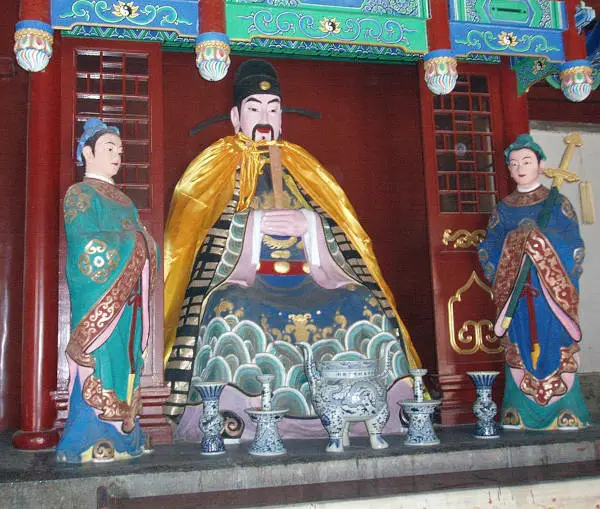
Han Xiang Zi (韓湘子)
His element is wood, and his direction is southeast. He is a master of the five phases of energy and a specialist in the mysteries of heaven. The holy knots on his robe represent his triumph in fusing the Yin and Yang forces into the One Original Energy.
He is frequently shown with a bunch of flowers and a flute, which he uses to perform the Six Healing Sounds. He is seen riding an ox, a legendary beast.
Zhang Guo Lao (張果老)
His element is water, and his direction is north. His symbol is a tube with wands, or “phoenix feathers,” inside, which he uses to tell the future. He is reputed to help individuals who have died reincarnate into good places.
His image works best in bedrooms, especially for people attempting to have children. He is also considered quite good at bestowing the skill of prophetic dreams upon you.
Related reading: Caishen – The Chinese God of Wealth and His Role in Chinese Culture and Feng Shui– Opens in new tab
Zhongli Quan (鐘离權)
His element is wood, and his direction is east. He is depicted as having a beard and wearing slacks. On both sides of his head, he has coiled up his hair. His emblem is a fan, which he employs to resurrect and reincarnate the souls of those who have recently died. He is over 1,800 years old and is supposed to visit the Earth periodically as a messenger of the Gods of Heaven.
He’s riding a Chi Lin, a legendary animal revered by Taoists. He will bring honorable sons into your family and engage the powerful assistance of the magical Tai Sui, commonly known as the Grand Duke Jupiter if you invite him into your home. It is thought that if you have offended the Tai Sui, keeping his figure in your home can pacify him, protecting you from misfortunes. He represents longevity.
Final Thoughts
The Eight Immortals are still popular figures in Taoism and Chinese culture, not only because they are associated with longevity and prosperity, but also because they were popular heroes among the masses, curing diseases, fighting the oppression of the weak, and even assisting people in attaining spirituality. Even though they are a mix of fact and fiction, they are still important to Chinese culture. Furthermore, employing the Eight Immortals as a feng shui sign ensures good feng shui.
Related reading: Guanyin: The Goddess Who Listens to the Cries of the World – Opens in new tab
Stay in Touch
 Join our newsletter by using the forms on this website or click here!
Join our newsletter by using the forms on this website or click here! Follow us on Google News
Follow us on Google News Follow us on Facebook
Follow us on Facebook
Featured Photo by Joe Mabel from Wikimedia Commons (CC BY-SA 3.0)

